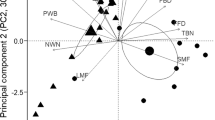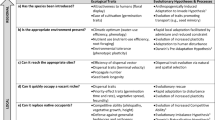Abstract
Classical examples indicated rapid evolution to be both rare and largely anthropogenic. As the pace and scale of human disturbance increase, such evolution is becoming more the norm. Genetically based adaptation may underlie successful biological invasions, and may likewise characterize responses in natives to invasives. Recent published studies confirm that natives are adapting morphologically, behaviorally, physiologically and life historically to selection from invasive species. Some of the processes involved are evident in our studies of recent host shifts to invasive plants by native soapberry bugs in North America and Australia. On both continents populations have differentiated extensively in fitness traits. Genetic architecture of these adaptations involves a surprising degree of non-additive variation (epistasis, dominance), a result that in theory may reflect a history of colonization by a small number of individuals followed by population growth. Such “founder-flush” events may unleash extraordinary evolutionary potential, and their importance will be clarified as more studies take advantage of the accidental perturbation experiments that biotic invasions represent. From a conservation standpoint, rapid evolution in natives will present challenges for ecologically appropriate and sustainable management, but at the same time may enhance the capacity of the native community to act in the biological control of invasive species.

Similar content being viewed by others
References
Agrawal AF, Brodie ED III, Rieseberg LH (2001) Possible consequences of genes of major effect: transient changes in the G-matrix. Genetica 112–113:33–43
Armbruster P, Bradshaw WE, Holzapfel CM (1997) Evolution of the genetic architecture underlying fitness in the pitcher-plant mosquito, Wyeomyia smithii. Evolution 51:451–458
Balanyà J, Serra L, Gilchrist GW, Huey RB, Pascual M, Mestres F, Solé E (2003) Evolutionary pace of the chromosomal polymorphism of Drosophila subobscura in colonizing populations. Evolution 57:1837–1845
Batianoff GN, Butler DW (2002) Assessment of invasive naturalized plants in south-east Queensland. Plant Prot Q 17:27–34
Blows MW, Hoffmann AA (1996) Evidence for an association between nonadditive genetic variation and extreme expression of a trait. Am Nat 148:576–587
Bradshaw WE, Holzapfel CM (2000) The evolution of genetic architecture and the divergence of natural populations. In: Wolf JB, Brodie ED III, Wade MJ (eds) Epistasis and the evolutionary process. Oxford University Press, Oxford, pp 245–263
Brodie ED III (2000) Why evolutionary genetics does not always add up. In: Wolf JB, Brodie ED III, Wade MJ (eds) Epistasis and the evolutionary process. Oxford University Press, Oxford, pp 3–19
Carroll SP, Boyd C (1992) Host race radiation in the soapberry bug: natural history, with the history. Evolution 46:1052–1069
Carroll SP, Loye JE (1987) Specialization of Jadera species (Hemiptera: Rhopalidae) on seeds of the Sapindaceae, and coevolution of defense and attack. Ann Entomol Soc Am 80:373–378
Carroll SP, Dingle H, Klassen SP (1997) Genetic differentiation of fitness-associated traits among rapidly evolving populations of the soapberry bug. Evolution 51:1182–1188
Carroll SP, Dingle H, Klassen SP (1998) Rapidly evolving adaptations to host ecology and nutrition in the soapberry bug. Evol Ecol 12:955–968
Carroll SP, Dingle H, Famula TR, Fox CW (2001) Genetic architecture of adaptive differentiation in evolving host races of the soapberry bug (Jadera haematoloma). Genetica 112–113:257–272
Carroll SP, Dingle H, Famula TR (2003a) Rapid appearance of epistasis during adaptive divergence following colonization. Proc R Soc Lond B 270(Suppl.):S80–S83
Carroll SP, Marler M, Winchell R, Dingle H (2003b) Evolution of cryptic flight morph and life history differences during host race radiation in the soapberry bug, Jadera haematoloma Herrich-Schaeffer (Hemiptera: Rhopalidae). Ann Entomol Soc Am 96:135–143
Carroll SP, Loye JE, Dingle H, Mathieson M, Famula T, Zalucki M (2005a) And the beak shall inherit—evolution in response to invasion. Ecol Lett 8:944–951
Carroll SP, Loye JE, Dingle H, Mathieson M, Zalucki M (2005b) Ecology of Leptocoris Hahn (Hemiptera: Rhopalidae) soapberry bugs in Australia. Aust J Entomol 44:344–353
Carroll SP, Mathieson M, Loye J (2005c) Invasion history and ecology of the environmental weed balloon vine, Cardiospermum grandiflorum Swartz, in Australia. Plant Prot Q 20:140–144
Charlesworth B (1998) The effect of synergistic epistasis on the inbreeding load. Genet Res Camb 71:85–89
Cheverud JE, Routman EJ (1996) Epistasis as a source of increased additive genetic variance at population bottlenecks. Evolution 50:1042–1051
Colautti RI, Ricciardi A, Grigorovich IA, MacIsaac HJ (2004) Is invasion success predicted by the enemy release hypothesis? Ecol Lett 7:721–733
Cox GW (2004) Alien species and evolution. Island Press, Washington
Coyne JA, Barton NH, Turelli M (2000) Is Wright’s shifting balance process important in evolution? Evolution 54:306–317
Crnokrak P, Roff DA (1995) Dominance variance: associations with selection and fitness. Heredity 75:530–540
Darwin C (1962) The voyage of the Beagle (reprint of the 1860 edition). Doubleday, New York
Elton CS (1958) The ecology of invasions by plants and animals. Wiley, New York
Endler JA (1986) Natural selection in the wild. Princeton University Press, Princeton
Etterson JR (2004) Evolutionary potential of Chamaecrista fasciculata in relation to climate change. II. Genetic architecture of three populations reciprocally planted along an environmental gradient in the great plains. Evolution 58:1459–1471
Falconer DS, MacKay TFC (1996) Introduction to quantitative genetics. Longman, New York
Feder JL, Berlocher SH, Roethele JB, Dambroski H, Smith JJ, Perry WL, Gavrilovic V, Filchak KE, Rull J, Aluja M (2003) Allopatric genetic origins for sympatric host plant shifts and race formation in Rhagoletis. Proc Natl Acad Sci USA 100:10314–10319
Fenster CB, Galloway LF (2000) The contribution of epistasis to the evolution of natural populations: a case study of an annual plant. In: Wolf JB, Brodie ED III, Wade MJ (eds) Epistasis and the evolutionary process. Oxford University Press, Oxford, pp 232–244
Goodnight CJ (1988) Epistasis and the effect of founder events on the additive genetic variance. Evolution 42:441–454
Goodnight CJ, Wade MJ (2000) The ongoing synthesis: a reply to Coyne, Barton and Turelli. Evolution 54:317–324
Hard JJ, Bradshaw WE, Holzapfel CM (1992) Epistasis and the genetic divergence of photoperiodism between populations of the pitcher-plant mosquito, Wyeomyia smithii. Genetics 131:389–396
Hatfield T (1997) Genetic divergence in adaptive characters between sympatric species of stickleback. Am Nat 149:1009–1029
Hendry AP, Wenburg JK, Bentzen P, Volk EC, Quinn TP (2000) Rapid evolution of reproductive isolation in the wild: evidence from introduced salmon. Science 290:516–518
Janzen DH (1973) Host plants as islands: competition in evolutionary and contemporary time. Am Nat 107:786–790
Kiesecker JM, Blaustein AR (1997) Population differences in responses of red-legged frogs (Rana aurora) to introduced bullfrogs. Ecology 78:1752–1760
Kinloch BB, Sniezko RA, Dupper GE (2003) Origin and distribution of Cr2, a gene for resistance to white pine blister rust in natural populations of western white pine. Phytopathology 93:691–694
Kruuk LEB, Clutton-Brock TH, Slate J, Pemberton S, Guinness FE (2000) Heritability of fitness in a wild mammal population. Proc Natl Acad Sci USA 97:698–703
Lair KP, Bradshaw WE, Holzapfel CM (1997) Evolutionary divergence of the genetic architecture underlying photoperiodism in the pitcher plant mosquito, Wyeomyia smithii. Genetics 147:1873–1883
Lambrinos JG (2004) How interactions between ecology and evolution influence contemporary invasion dynamics. Ecology 85:2061–2070
Lee CE (2002) Evolutionary genetics of invasive species. Trends Ecol Evol 17:386–391
Majerus MEN (1998) Melanism: evolution in action. Oxford University Press, Oxford
Mather K, Jinks JL (1982) Biometrical genetics: the study of continuous variation. Chapman & Hall, London
Merilä J, Sheldon BC (1999) Genetic architecture of fitness and non-fitness traits—empirical patterns and development of ideas. Heredity 83:103–109
Orr HA, Coyne JA (1992) The genetics of adaptation: a reassessment. Am Nat 140:725–742
Phillips BL, Shine R (2004) Adapting to an invasive species: toxic cane toads induce morphological change in Australian snakes. Proc Natl Acad Sci USA 101:17150–17155
Quinn TP, Kinnison MT, Unwin MJ (2001) Evolution of chinook salmon (Oncorhynchus tshawytscha) populations in New Zealand: pattern, rate and process. Genetica 112–113:493–513
Regan JL, Meffert LM, Bryant EH (2003) A direct experimental test of founder-flush effects on the evolutionary potential for assortative mating. J Evol Biol 16:302–312
Rejmánek M, Richardson DM, Higgins SI, Pitcairn M, Grotkopp E (2004) Invasive species: a new synthesis. In: Mooney HA, McNeeley JA, Neville L, Schei PJ, Waage J (eds) Invasive alien species: search for solutions. Island Press, Washington
Reznick D, Ghalambor CK (2001) The population ecology of contemporary adaptations: what empirical studies reveal about the conditions that promote adaptive evolution. Genetica 112–113:183–198
Roff DA (1998) Evolutionary quantitative genetics. Chapman & Hall, London
Shea K, Chesson P (2002) Community ecology theory as a framework for biological invasions. Trends Ecol Evol 17:170–176
Siegler DS, Kawahara W (1976) New reports of cyanolipids from sapindaceous plants. Biochem Syst Ecol 4:263–265
Singer MC, Thomas CD, Parmesan C (1993) Rapid human-induced evolution of insect–host associations. Nature 366:681–683
Smith TB, Freed LA, Lepson JK, Carothers JH (1995) Evolutionary consequences of extinctions in populations of a Hawaiian honeycreeper. Conserv Biol 9:107–113
Southwood TRE (1977) Habitat, the template for ecological strategies? J Anim Ecol 46:337–365
Southwood TRE, Kennedy CEJ (1983) Trees as islands. Oikos 41:359–371
Stearns SC (1983) The evolution of life-history traits in mosquito fish since their introduction to Hawaii in 1905: rates of evolution, heritabilities, and developmental plasticity. Am Zool 23:65–76
Strauss SY, Lau JA, Carroll SP (2006) Evolutionary responses of natives responding to introduced species: what do introductions tell us about natural communities. Ecol Lett 9:357–374
Templeton AR (2000) Epistasis and complex traits. In: Wolf JB, Brodie ED III, Wade MJ (eds) Epistasis and the evolutionary process. Oxford University Press, Oxford, pp 41–57
Vermeij GJ (1996) An agenda for invasion biology. Biol Conserv 78:3–9
Vourc’h G, Martin JL, Duncan P, Escarre J, Clausen TP (2001) Defensive adaptations of Thuja plicata to ungulate browsing: a comparative study between mainland and island populations. Oecologia 126:84–93
Wade MJ (2001) Epistasis, complex traits, and mapping traits. Genetica 112–113:59–69
Wade MJ (2002) A gene’s eye view of epistasis. J Evol Biol 15:337–346
Wolf JB, Brodie ED III, Wade MJ (2000) Epistasis and the evolutionary process. Oxford University Press, Oxford
Yoshida T, Jones LE, Ellner SP, Fussman GF, Hairston NG Jr (2003) Rapid evolution drives ecological dynamics in a predator–prey system. Nature 424:303–306
Acknowledgments
I thank Hugh Dingle and Jenella Loye for their partnership throughout the research presented here. Tom Famula, Michael Mathieson and Myron Zalucki have been involved in many aspects of our work. I thank the editors for the opportunity to participate in this volume, and an anonymous reviewer for pointing out weaknesses in the original draft. Funding has been provided by NSF, the Australian–American Fulbright Commission, and Carroll-Loye Biological Research, with further support from the School of Life Sciences, University of Queensland and the Queensland Environmental Protection Agency.
Author information
Authors and Affiliations
Corresponding author
Rights and permissions
About this article
Cite this article
Carroll, S.P. Brave New World: the epistatic foundations of natives adapting to invaders. Genetica 129, 193–204 (2007). https://doi.org/10.1007/s10709-006-9014-8
Received:
Accepted:
Published:
Issue Date:
DOI: https://doi.org/10.1007/s10709-006-9014-8




